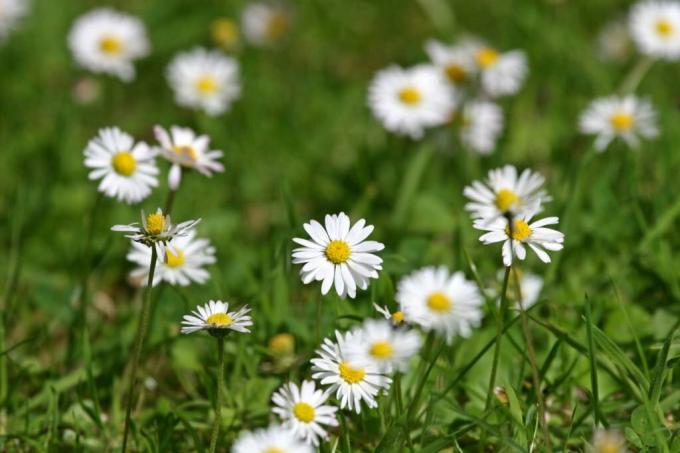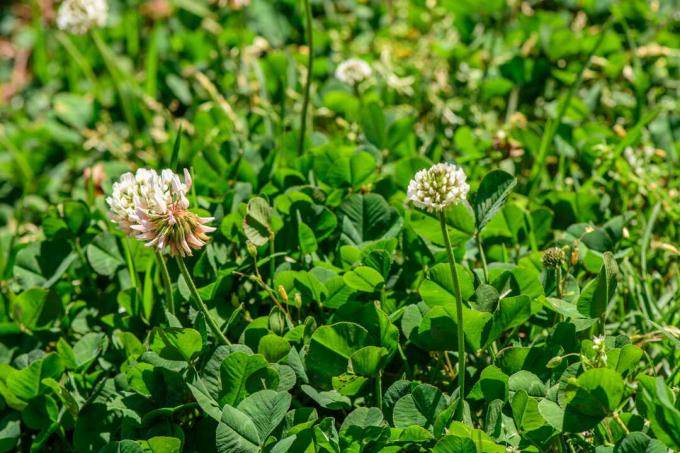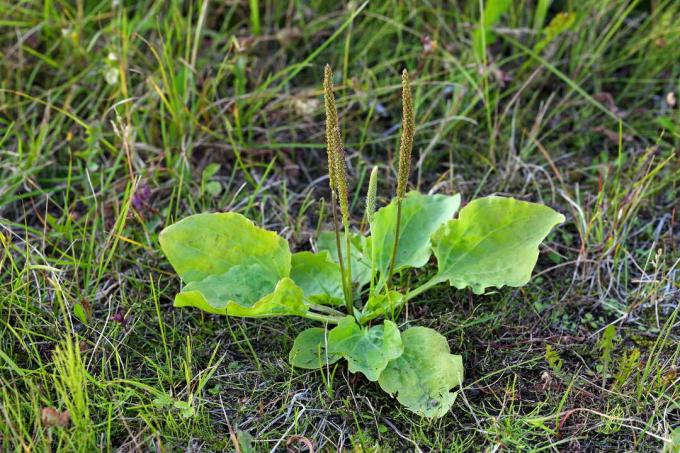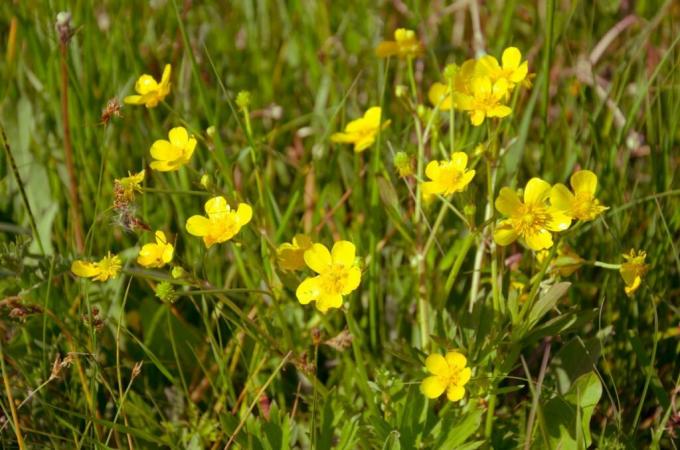Weeds sometimes creep into places where only grass should actually grow. We offer various methods to control weeds.

The appearance and composition of unwanted companion plants in your lawn are no accident. The initial pre-turf preparations, soil type, mowing routine and soil pH favor a very specific accumulation of weeds. These weeds are perfectly adapted to the conditions prevailing on your lawn. They can often be contained or driven away by changes in site conditions. Poor soil preparation is difficult to undo and there are only minor changes to soil type. But with well-planned care measures and changing mowing and fertilizing habits, you can effectively make life difficult for many weeds.
contents
-
Properly identify weeds in the lawn
- Root weeds in the lawn
- Seed weeds in the lawn
-
The most common weeds in the lawn
- Dandelion (Taraxacum officinale)
- Daisy (Bellis perennis)
- White clover (Trifolium repens)
- Broad plantain (Plantago major)
- Creeping Buttercup (Ranunculus repens)
- Speedwell (Veronica species)
-
Destroy weeds in the lawn
- Home remedies to get rid of weeds in the lawn
- Weed killer against weeds in the lawn
Properly identify weeds in the lawn
When controlling weeds or grass weeds, it is of great importance whether the unwanted plants are seed or root weeds. Because these two groups have a different survival strategy and must therefore also be combated with other measures.
Root weeds in the lawn
Most root weeds grow quickly and have a high adaptability to unfavorable environmental conditions such as poorly drained soils. They can also propagate via seeds, but are characterized above all by their distinctive rootstock. This rhizome enables the root weeds to survive for several years and has a very high regenerative capacity. Combating most root weeds is rather tedious and tedious. The often deep roots must be completely removed. The plants store nutrients in it in order to be able to sprout again and again.

Seed weeds in the lawn
Seed weeds are usually annuals, meaning they die off after a growing season. In order for their species to survive, these plants produce large numbers of seeds. Seed weeds are therefore best combated by removing them before seed formation, for example by mowing the lawn during flowering. However, birds or the wind can carry seeds of the same weeds back onto your lawn next year. However, if you always remove the flowers in good time, a lawn-displacing spread can easily be averted.
The most common weeds in the lawn
Below you will find the most common weeds found in lawns, the causes of their appearance and ways to combat them.
Dandelion (Taraxacum officinale)
The common dandelion prefers nutrient-rich, deep loamy soil, but actually occurs almost everywhere. Characteristic are its yellow cup-shaped flowers and its large, coarsely toothed leaves, which form a basal rosette. Especially in patchy turf, the dandelion spreads quickly and robs the lawn of a lot of space. With its strong taproot, the dandelion is one of the perennial weeds. The seeds of the dandelion are very widely spread by the wind. The best way to protect your lawn from dandelions is to carefully pull the plants out of the ground with a weed puller, including the entire taproot. To prevent further spread, mowing is done before the yellow flower turns into a dandelion.

Daisy (Bellis perennis)
Similar to the dandelion, the daisy defies frequent and deep lawn mowing. The beautiful little flowers are very adaptable and do not have any great demands on the soil. Due to the formation of short runners and many seeds, the visually appealing little plant can spread quickly. Single plants can be easily removed with the weed puller. Any gaps are resown with grass.

White clover (Trifolium repens)
White clover is also common in lawns and provides a welcome source of nectar for bees. Hobby beekeepers therefore only mow the lawn after flowering - but before the seed formation. If you want to protect barefoot walkers or children from bee stings, mow before flowering or try to get rid of the white clover.
Clover loves nutrient-rich soil, but can still grow on the poorest sandy soil. Getting rid of it is very difficult, which is why every part of the plant must be removed early on. Regular mowing before the clover starts to form seeds is particularly important so that it doesn't spread any further.
If the clover is only represented in places, it is worth cutting out generously and then doing one more Lawn Repair.
tip: We have more hints how to Combat clover in the lawn and can prevent, put together for you.

If the clover is established in the entire lawn, unfortunately nothing helps except the use of a selective herbicide or the complete uprooting of the lawn and reseeding - of course after removing all parts of the clover from the soil Has.
By the way: In landscaping, the vigorous and cut-tolerant clover is also often used as a lawn substitute. If you want to live with the subtenant, you can simply leave him on the lawn. It is only important to take good care of the lawn and not to mow it too deep so that it is not crowded out by the clover.
Broad plantain (Plantago major)
The broadleaf plantain is - just like its brother the buckhorn (Plantago lanceolata) – a very resilient plant. For this reason we know the two of them from cow pastures or forest roads. Plantains can spread very quickly and unpleasantly and take up a lot of space. The individual plants are best cut out.
Tip: If you are bitten by an insect in nature and you happen to see a plantain immediately, you are lucky in misfortune. Chew up a buckhorn leaf and apply the slightly disgusting leaf and saliva mixture to the insect bite. The active ingredients of the leaf help against the swelling.

Creeping Buttercup (Ranunculus repens)
The plant, which belongs to the poisonous buttercup family, is also popularly known as "buttercup". As the name suggests, the plant with the beautiful yellow flowers forms creeping stolons that can become uncontrollable. Single plants should be pinched out as early as possible to prevent spread. Creeping buttercups do best in wet, poorly drained soil. In the long term, it can therefore be reduced by better drainage of the soil.

Speedwell (Veronica species)
The pale purple flowers of the speedwell are deceptively beautiful. The proliferating and runner-forming speedwell creates real cushions in the lawn and thus suffocates the grasses. It is difficult to combat, so it is worth acting immediately when the first infestation occurs. If there are only a few nests at first, these are cut out over a large area. Of course, the resulting gaps are then overseed. If the honorary award has already spread further, that helps scarifying the lawn after flowering (before seed formation) as this weakens the plant. The scarified material should be removed carefully and should never be put on the compost. Also common mowing doesn't like the speedwell.

Other common lawn weeds are yarrow (Achilea millefolium), crawling bugle (Ajuga reptans), hop clover (Medicago lupulina, also called yellow clover) and Chickweed (Stellaria media). However, in the way they are successfully combated, they do not differ significantly from the weeds described. Two weeds, the couch grass (Elymus repens) and the common panicle (Poa trivialis), are probably only really perceived as annoying by particularly hard-working ornamental lawn gardeners. However, not even the usual lawn herbicides work against them.
Destroy weeds in the lawn
Preventing weed infestation is worthwhile and usually less of a hassle than later ridding a heavily weeded lawn of companion plants.
What can be done to prevent weeds in the lawn?
- Before laying the lawn, the soil should be prepared in such a way that it is permeable to water and air. This increases the competitive power of the lawn grass against the weeds.
- Subsequently, through regular lawn aeration and lawn sands improve the water and air permeability of the soil. Our fine-grained, easy-to-distribute powder is ideal for sanding Plantura lawn sand which can be distributed for improved root aeration. A lawn with healthy, strong roots is much more competitive with weeds and cannot be pushed out as quickly.
- If you have particularly heavy soil, which can only be slightly improved by drainage or adding sand, you should use seeds that are adapted to the location. Some grasses cope better with heavy soil and then have a higher resistance to weeds than other grasses.
- The pH of the soil can be checked and brought into the optimal range for lawns. To do this, you may need your lime the lawn. A pH value that is too low is a frequent driver of wild herbs and moss in the lawn. A high-quality, fine-grained lime is ours, for example Plantura garden lime, which brings acidic soils back into balance.
- Many weeds do not cope well with the constant loss of mass when mowing. So they can be kept in check by frequent, deep mowing.
- To prevent weeds, the lawn should be fertilized regularly and appropriately. Lawn is a nutrient-hungry garden dweller. A lawn fertilizer should be nitrogen-heavy in spring and potassium-heavy in late summer or fall - that's good for you dense, frost and drought tolerant lawn that is not easily overtaken by less demanding weeds will. Our Plantura organic lawn fertilizer and ours Plantura Organic Autumn Lawn Fertilizer are precisely adapted to the needs of the lawn grass and provide all the necessary nutrients.

Home remedies to get rid of weeds in the lawn
Almost every lawn owner has problems with weeds in the lawn if the weeds bother them. All the more myths circulate among hobby gardeners about the best control methods.
Which home remedies help against weeds, which are more harmful?
- salt and vinegar: Many people know salt and vinegar as natural all-purpose household products and think they can also be used in the garden. But in nature, salt and vinegar not only damage weeds, but also the surrounding plants and soil. Vinegar and salt therefore have absolutely no place in the garden.
- Hot water: If reseeding is planned, weeds can be sprinkled with hot water before cutting out. After drying, they can be easily removed. If you don't want to overseed, there is too great a risk with this method that the lawn will also be destroyed.
- Flaming before replanting: For areas on which, for example, the Newly laid lawn must - i.e. the lawn has to give way anyway - careful weeding is necessary. The entire area can be flamed with the help of weed burners. Dark plastic sheets can be spread out on the surface and weighed down. The warmer it is, the faster the underlying vegetation will die.
- Prevent and cut out in time: The best "home remedy" against weeds is and remains early, careful cutting out of the weeds together with all their roots. This is a good way to prevent weed infestation that crowds the lawn.
Important: After weeding, do not forget to close any gaps in the turf caused by weeds. Even gaps that have arisen in other ways must always be reseeded to avoid weed infestation. It is best to use special fast-growing seeds like ours to repair bald spots Plantura lawn repair. If the soil has not been fertilized immediately before, it can be fertilized. Closing gaps and fertilizing will help the lawn become competitive against weeds again. Because gaps and bare spots really attract weeds to use the free space for their purposes.
Weed killer against weeds in the lawn
Although some weeds only grow mechanically with a lot of persistence or sometimes not in to a satisfactory degree, chemical weed killers should really be the last resort be solution. The use of a so-called herbicide has many disadvantages from an ecological point of view and should be carefully considered. Before resorting to a weed killer, one must always be aware that the lawn in the garden can also be an area that contributes to the biodiversity of flora and fauna. In home gardens, where children or pets may be playing on the lawn, it is better not to use weed killers anyway.

Weed killer in the test
Most lawn herbicides are based on active ingredients that specifically intervene in the metabolism of dicotyledonous, i.e. herbaceous plants. When they are used, monocotyledonous plants, including lawn grasses, are spared. However, the monocot weeds remain unaffected, for example the particularly unpleasant bluegrass (Poa annua) or the haystacks (Lazula campestris). Many weeds such as speedwell, plantain and daisy are very hardy and need two or more herbicide applications, each spaced four to six weeks apart are. The chemical destruction of weeds is not done with the quick spraying - especially because after the weed destruction, overseeding and fertilizing follow.
Important notes when using herbicides:
- Keep in mind that most lawn weed killers will kill all dicot plants. Flowers and vegetables must therefore be protected from spray drift.
- The best application periods are in spring and late summer. These times of the year are also ideal for subsequent reseeding.
- Observe all warnings, usage information and protective regulations on the product label or insert.
Mix lawn fertilizer with weed killer: is that possible?
Lawn in combination with weeds may not be ideal for some, but has the advantage that it creates a closed green carpet. After using weed killers, the lawn often looks completely different: it is bare and anything but closed. Therefore, after the herbicide application, a Lawn reseeding and also one lawn fertilization take place. The fertilizer strengthens the remaining grass and the overseeding closes the gaps in the turf. Weed killers that are combined with lawn fertilizer already do two out of three work steps and then only have to be supplemented with mechanical overseeding. If the overseeding is done with a spreader, seed and fertilizer can of course also be combined there.
Proper care is an important measure to prevent weeds. In our article you will find out everything about Lawn care all year round.
